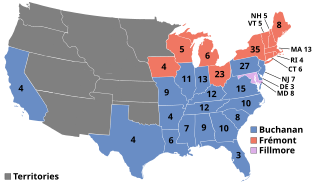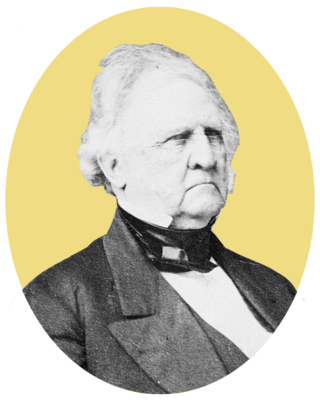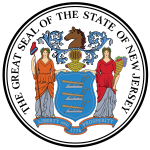
Presidential elections were held in the United States on November 2, 1852. Democratic nominee Franklin Pierce defeated Whig nominee General Winfield Scott.

Presidential elections were held in the United States on November 4, 1856. Democratic nominee James Buchanan defeated Republican nominee John C. Frémont and Know Nothing/Whig nominee Millard Fillmore. The main issue was the expansion of slavery as facilitated by the Kansas–Nebraska Act of 1854. Buchanan defeated President Franklin Pierce at the 1856 Democratic National Convention for the nomination. Pierce had become widely unpopular in the North because of his support for the pro-slavery faction in the ongoing civil war in territorial Kansas, and Buchanan, a former Secretary of State, had avoided the divisive debates over the Kansas–Nebraska Act by being in Europe as the Ambassador to the United Kingdom.

William Lewis Dayton was an American politician, active first in the Whig Party and later in the Republican Party. In the 1856 presidential election, he became the first Republican vice-presidential nominee when nominated alongside John C. Frémont. The Republican Party lost that campaign. During the American Civil War, Dayton served as the United States Ambassador to France, a position in which he worked to prevent French recognition of the Confederate States of America.

Andrew Jackson Donelson was an American diplomat and politician. He served in various positions as a Democrat and was the Know Nothing nominee for US vice president in 1856.

The 1856 Republican National Convention was a presidential nominating convention that met from June 17 to June 19, 1856, at Musical Fund Hall at 808 Locust Street in Philadelphia, Pennsylvania. It was the first national nominating convention of the Republican Party, founded two years earlier in 1854. It was held to nominate the party's candidates for president and vice president in the 1856 election. The convention selected John C. Frémont, a former United States Senator from California, for president, and former Senator William L. Dayton of New Jersey for vice president. The convention also appointed members of the newly established Republican National Committee.

The 1856 Whig National Convention was a presidential nominating convention held from September 17 to September 18, in Baltimore, Maryland. Attended by a rump group of Whigs who had not yet left the declining party, the 1856 convention was the last presidential nominating convention held by the Whig Party. The convention nominated a ticket consisting of former president Millard Fillmore and former ambassador Andrew J. Donelson; both had previously been nominated by the 1856 American National Convention. The Whig ticket finished third in the 1856 presidential election behind the winning Democratic ticket of James Buchanan and John C. Breckinridge and the runner-up Republican ticket of John C. Frémont and William L. Dayton.

The 1852 Whig National Convention was a presidential nominating convention held from June 16 to June 21, in Baltimore, Maryland. It nominated the Whig Party's candidates for president and vice president in the 1852 election. The convention selected General-in-Chief Winfield Scott for president and U.S. secretary of the navy William A. Graham for vice president.
The 1860 Constitutional Union National Convention met on May 9, 1860, in Baltimore, Maryland. It was the only national convention ever held by the Constitutional Union Party, which was organized largely by former Whig Party members from the Southern United States who opposed secession. The convention nominated former Senator John Bell of Tennessee for president and former Secretary of State Edward Everett of Massachusetts for vice president.

William Augustus Newell, was an American physician and politician who served as the 18th Governor of New Jersey and 11th Governor of the Washington Territory.

Joseph Dorsett Bedle, Sr. was an American attorney, jurist, and Democratic Party politician who served as the 23rd governor of New Jersey from 1875 to 1878.
The 1856 Democratic National Convention was a presidential nominating convention that met from June 2 to June 6 in Cincinnati, Ohio. It was held to nominate the Democratic Party's candidates for president and vice president in the 1856 election. The convention selected former Secretary of State James Buchanan of Pennsylvania for president and former Representative John C. Breckinridge of Kentucky for vice president.

The 1856 New York state election was held on November 4, 1856, to elect the governor, the lieutenant governor, a Canal Commissioner, an Inspector of State Prisons and the Clerk of the Court of Appeals, as well as all members of the New York State Assembly.
William Cowper Alexander was an American lawyer, politician, and insurance executive. He served as President of the New Jersey State Senate and as President of the Equitable Life Assurance Society.

The 1856 United States presidential election in Virginia took place on November 4, 1856, as part of the 1856 United States presidential election. Voters chose 15 representatives, or electors to the Electoral College, who voted for president and vice president.

The 1859 New Jersey gubernatorial election was held on November 8, 1859. Opposition Party nominee Charles Smith Olden defeated Democratic nominee Edwin R. V. Wright with 50.76% of the vote.

The 1856 United States presidential election in New York took place on November 4, 1856, as part of the 1856 United States presidential election. Voters chose 35 representatives, or electors to the Electoral College, who voted for president and vice president.

The 1856 United States presidential election in Ohio took place on November 4, 1856, as part of the 1856 United States presidential election. Voters chose 23 representatives, or electors to the Electoral College, who voted for president and vice president.
The 1856 American National Convention was held in National Hall in Philadelphia, Pennsylvania, on February 22 to 25, 1856. The American Party, formerly the Native American Party, was the vehicle of the Know Nothing movement. The convention resulted in the nomination of former President Millard Fillmore from New York for president and former Ambassador Andrew Jackson Donelson from Tennessee for vice president.

The 1856 Massachusetts gubernatorial election on November 4. Incumbent Know-Nothing governor Henry J. Gardner was re-elected to a third term. He benefited greatly from a deal with the state's new Republican Party, which agreed not to field a candidate in exchange for Gardner's support of presidential nominee John C. Frémont. With no serious challenger in the field against him, Gardner easily defeated Democrat Erasmus Beach and George W. Gordon, an American Party member running in support of the national ticket.

The 1856 New York gubernatorial election was held on November 4, 1856. Incumbent Governor Myron Clark did not run for re-election to a second term in office. In the race to succeed him, John A. King defeated Amasa J. Parker and Erastus Brooks to become the first Republican elected Governor of New York.

















